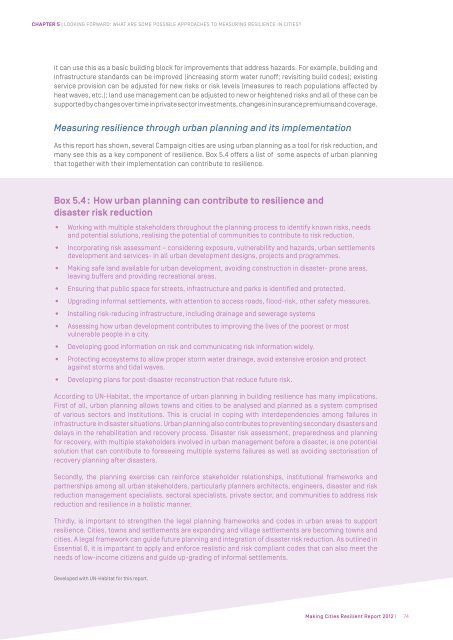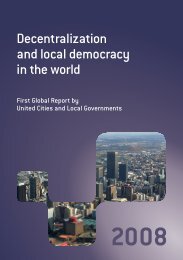Making Cities Resilient Report 2012
Making Cities Resilient Report 2012
Making Cities Resilient Report 2012
Create successful ePaper yourself
Turn your PDF publications into a flip-book with our unique Google optimized e-Paper software.
CHAPTER 5 | LOOKING FORWARD: WHAT ARE SOME POSSIBLE APPROACHES TO MEASURING RESILIENCE IN CITIES<br />
it can use this as a basic building block for improvements that address hazards. For example, building and<br />
infrastructure standards can be improved (increasing storm water runoff; revisiting build codes); existing<br />
service provision can be adjusted for new risks or risk levels (measures to reach populations affected by<br />
heat waves, etc.); land use management can be adjusted to new or heightened risks and all of these can be<br />
supported by changes over time in private sector investments, changes in insurance premiums and coverage.<br />
Measuring resilience through urban planning and its implementation<br />
As this report has shown, several Campaign cities are using urban planning as a tool for risk reduction, and<br />
many see this as a key component of resilience. Box 5.4 offers a list of some aspects of urban planning<br />
that together with their implementation can contribute to resilience.<br />
Box 5.4 : How urban planning can contribute to resilience and<br />
disaster risk reduction<br />
• Working with multiple stakeholders throughout the planning process to identify known risks, needs<br />
and potential solutions, realising the potential of communities to contribute to risk reduction.<br />
• Incorporating risk assessment – considering exposure, vulnerability and hazards, urban settlements<br />
development and services- in all urban development designs, projects and programmes.<br />
• <strong>Making</strong> safe land available for urban development, avoiding construction in disaster- prone areas,<br />
leaving buffers and providing recreational areas.<br />
• Ensuring that public space for streets, infrastructure and parks is identified and protected.<br />
• Upgrading informal settlements, with attention to access roads, flood-risk, other safety measures.<br />
• Installing risk-reducing infrastructure, including drainage and sewerage systems<br />
• Assessing how urban development contributes to improving the lives of the poorest or most<br />
vulnerable people in a city.<br />
• Developing good information on risk and communicating risk information widely.<br />
• Protecting ecosystems to allow proper storm water drainage, avoid extensive erosion and protect<br />
against storms and tidal waves.<br />
• Developing plans for post-disaster reconstruction that reduce future risk.<br />
According to UN-Habitat, the importance of urban planning in building resilience has many implications.<br />
First of all, urban planning allows towns and cities to be analysed and planned as a system comprised<br />
of various sectors and institutions. This is crucial in coping with interdependencies among failures in<br />
infrastructure in disaster situations. Urban planning also contributes to preventing secondary disasters and<br />
delays in the rehabilitation and recovery process. Disaster risk assessment, preparedness and planning<br />
for recovery, with multiple stakeholders involved in urban management before a disaster, is one potential<br />
solution that can contribute to foreseeing multiple systems failures as well as avoiding sectorisation of<br />
recovery planning after disasters.<br />
Secondly, the planning exercise can reinforce stakeholder relationships, institutional frameworks and<br />
partnerships among all urban stakeholders, particularly planners architects, engineers, disaster and risk<br />
reduction management specialists, sectoral specialists, private sector, and communities to address risk<br />
reduction and resilience in a holistic manner.<br />
Thirdly, is important to strengthen the legal planning frameworks and codes in urban areas to support<br />
resilience. <strong>Cities</strong>, towns and settlements are expanding and village settlements are becoming towns and<br />
cities. A legal framework can guide future planning and integration of disaster risk reduction. As outlined in<br />
Essential 6, it is important to apply and enforce realistic and risk compliant codes that can also meet the<br />
needs of low-income citizens and guide up-grading of informal settlements.<br />
Developed with UN-Habitat for this report.<br />
<strong>Making</strong> <strong>Cities</strong> <strong>Resilient</strong> <strong>Report</strong> <strong>2012</strong> | 74

















